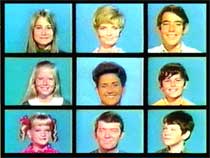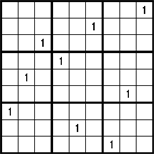Visual Elimination
(or what I like to call "The Brady Bunch technique")
Most people try to solve Sudoku puzzles by picking a random empty cell and trying to figure out what goes in it. Unless you get lucky, this ends up being frustrating and tedious.
"Visual Elimination" is sort of the opposite of that. Instead of focusing on a particular cell, you focus on a number, and try to figure out the nine places it goes.
That's right — every number goes into every Sudoku puzzle exactly nine times. No more, no less. Each puzzle has nine 1s, nine 2s, nine 3s, etc.
 Ok, now train yourself to look at just the larger squares in the puzzle. Think of the puzzle as a tic-tac-toe game, or a "Brady Bunch" grid (remember The Brady Bunch?). In other words, only focus on the nine large squares (called "blocks"). Ok, now train yourself to look at just the larger squares in the puzzle. Think of the puzzle as a tic-tac-toe game, or a "Brady Bunch" grid (remember The Brady Bunch?). In other words, only focus on the nine large squares (called "blocks").
With me so far? Ok now, we pick a number — I like to start with "1". Because of the rules of the game, the puzzle must have exactly nine 1s, and there will be one in each tic-tac-toe square (block).

Now you may say, "of course" - but the reason I am pointing this out is I want you to train yourself to look at the puzzle this way. You may even need to squint a bit to see it. For instance:

On the left is what you normally see. On the right is what I want you to see. I want you to only focus on the 1s.
See them? There are five of them, right? Think of the puzzle as a Brady Bunch grid, and it becomes clear that Mrs. Brady, Cindy, Greg, and Bobby are still missing their "1".
No, this technique does not require you to memorize the position of each Brady Bunch character. I'm only trying to give you an easy way to picture the concept.
Ok, so we need to try to find the four missing 1s (Mrs. Brady, Cindy, Greg, and Bobby's). Let's see if we can find any of them using the other rules of Sudoku: we know that no "1" in the entire puzzle can be on the same row, or in the same column, so with a little bit further thinking, we can see exactly where they go!
Start with Cindy (lower left). Marsha & Jan's "1" dictate that Cindy's "1" must be along the left (it cannot be below any other "1"). One of those cells is already filled with a "4", and another would be in the same row as Mr. Brady's "1", which is also not allowed. So Cindy's "1" must be in the lower left cell of her block!
Mrs. Brady's "1" can also be located in this way, which in turn will show us where Greg's is, and then finally Bobby's!

Practice this enough, and it will become second nature to you.
Of course, there is no guarantee you will find all the 1s. If there were, you could always solve every Sudoku using this technique.
Once you have found every "1" you can find, simply move on to "2". Do the same thing for "3", "4", etc — all the way through "9".
Once you have finished with "9", don't get too excited - you are not done. If you used "Visual Elimination" to fill in any cells, you will want to go right back to "1" and try again. This is because every filled cell potentially changes things. You have only truly exhausted this technique when you go from "1" all the way through "9" without solving any new cells.
But there is some good news here: You can use this technique to fully solve probably around half of the Sudoku puzzles published in newspapers & magazines!
Most Sudoku puzzles printed in newspapers and magazines, even those rated with high levels of difficulty, are in fact quite easy to solve — at least from the perspective of someone who has mastered this technique.
"Visual Elimination" is probably the most important technique you can learn. If you only skimmed this page, I encourage you to go over it again.

|




